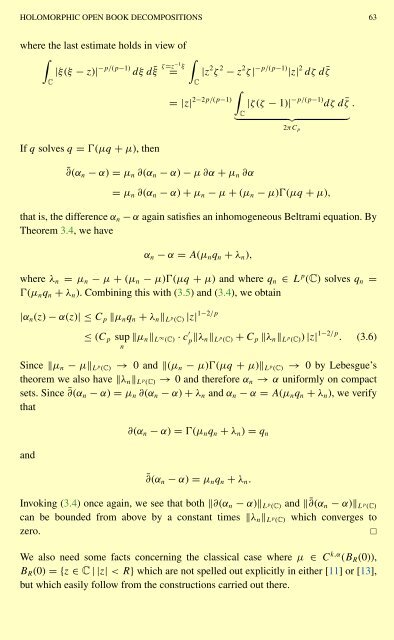NEAR OPTIMAL BOUNDS IN FREIMAN'S THEOREM
NEAR OPTIMAL BOUNDS IN FREIMAN'S THEOREM
NEAR OPTIMAL BOUNDS IN FREIMAN'S THEOREM
Create successful ePaper yourself
Turn your PDF publications into a flip-book with our unique Google optimized e-Paper software.
HOLOMORPHIC OPEN BOOK DECOMPOSITIONS 63<br />
where the last estimate holds in view of<br />
<br />
|ξ(ξ − z)| −p/(p−1) dξ d¯ξ ζ =z−1 <br />
ξ<br />
=<br />
C<br />
If q solves q = Ɣ(µq + µ),then<br />
C<br />
=|z| 2−2p/(p−1)<br />
¯∂(αn − α) = µn ∂(αn − α) − µ∂α+ µn ∂α<br />
|z 2 ζ 2 − z 2 ζ | −p/(p−1) |z| 2 dζ d¯ζ<br />
<br />
|ζ (ζ − 1)| −p/(p−1) dζ d¯ζ .<br />
C <br />
2πCp<br />
<br />
= µn ∂(αn − α) + µn − µ + (µn − µ)Ɣ(µq + µ),<br />
that is, the difference αn − α again satisfies an inhomogeneous Beltrami equation. By<br />
Theorem 3.4, wehave<br />
αn − α = A(µnqn + λn),<br />
where λn = µn − µ + (µn − µ)Ɣ(µq + µ) and where qn ∈ L p (C) solves qn =<br />
Ɣ(µnqn + λn). Combining this with (3.5)and(3.4), we obtain<br />
|αn(z) − α(z)| ≤Cp µnqn + λnL p (C) |z| 1−2/p<br />
≤ (Cp sup µnL<br />
n<br />
∞ (C) · c ′<br />
pλnLp (C) + Cp λnLp (C)) |z| 1−2/p . (3.6)<br />
Since µn − µLp (C) → 0 and (µn − µ)Ɣ(µq + µ)Lp (C) → 0 by Lebesgue’s<br />
theorem we also have λnLp (C) → 0 and therefore αn → α uniformly on compact<br />
sets. Since ¯∂(αn − α) = µn ∂(αn − α) + λn and αn − α = A(µnqn + λn), we verify<br />
that<br />
and<br />
∂(αn − α) = Ɣ(µnqn + λn) = qn<br />
¯∂(αn − α) = µnqn + λn.<br />
Invoking (3.4) once again, we see that both ∂(αn − α)L p (C) and ¯∂(αn − α)L p (C)<br />
can be bounded from above by a constant times λnL p (C) which converges to<br />
zero. <br />
We also need some facts concerning the classical case where µ ∈ C k,α (BR(0)),<br />
BR(0) ={z ∈ C ||z|

















